You’ve bought the lactic acid serum or body scrub. You’re ready to glow. But then you pause-should you put lactic acid on wet or dry skin? It’s not just a random question. Get this wrong, and you could end up with redness, stinging, or worse-no results at all. The truth? It’s not about what’s trendy. It’s about what your skin actually needs.
Short Answer: Use Lactic Acid on Dry Skin First
For best results, apply lactic acid to clean, dry skin. Let it sit for 10-20 minutes before rinsing or following up with moisturizer. If you’re using a lactic acid body scrub, apply it to damp (not soaking wet) skin. Wet skin dilutes the acid, making it less effective. Dry skin lets it penetrate properly-without washing away the active ingredients before they even start working.
Why Lactic Acid Works Better on Dry Skin
Lactic acid is an alpha hydroxy acid (AHA), and like all AHAs, it works by breaking down the glue that holds dead skin cells together. But here’s the catch: water interferes with that process. When your skin is wet, the acid gets diluted. It can’t bind to your skin’s surface the way it should. Think of it like trying to paint a wall while someone’s spraying water on it-you’re just washing the paint away.
Studies from the Journal of Clinical and Aesthetic Dermatology show that AHAs like lactic acid work more efficiently when applied to dry skin because they maintain their optimal pH level (usually between 3.0 and 4.0). Water raises the pH, making the acid less acidic-and less effective at exfoliating.
Also, wet skin is more permeable. That sounds good, right? But in reality, it means the acid can penetrate too fast, too deep, and cause irritation-especially if you’re using a higher concentration (above 10%). Dry skin gives you control. You apply it, wait, then rinse. No surprises.
What Happens If You Apply Lactic Acid to Wet Skin?
Let’s be real-some people swear by applying lactic acid in the shower. They say it feels soothing. And yeah, it might feel nice. But here’s what’s really going on:
- The product washes off too quickly-less time to work.
- Water dilutes the concentration-so you’re not getting the full benefit.
- Steam opens pores, but it also increases sensitivity. You’re more likely to get stinging or redness.
- Body wash or shampoo residues on your skin can react with the acid, causing irritation.
One client in Dubai, a 34-year-old yoga instructor, told me she switched from using her lactic acid scrub in the shower to applying it after a shower, on dry skin. Within two weeks, her rough elbows and back acne cleared up. She said: “I didn’t realize how much I was wasting the product before.”
When Wet Skin Actually Works-The Body Scrub Exception
Now, here’s the twist. If you’re using a lactic acid body scrub-a physical exfoliant mixed with lactic acid-you can apply it to slightly damp skin. Why? Because the scrubbing action does the heavy lifting. The lactic acid is there to enhance the physical exfoliation, not do it alone.
Think of it like this: the scrub grains are the shovel, and the lactic acid is the fertilizer. You need the shovel to dig first, then the fertilizer can soak in. So, step one: get your skin damp (not dripping wet). Step two: apply the scrub. Step three: massage gently for 60-90 seconds. Step four: rinse.
But if you’re using a leave-on lactic acid toner, serum, or peel? Dry skin only. No exceptions.

How to Use Lactic Acid Correctly (Step-by-Step)
Here’s exactly how to use lactic acid so it works-without burning your skin:
- Wash your face or body with a gentle cleanser. Pat dry with a towel-don’t rub.
- Wait 5 minutes. Let your skin fully dry. No moisture left.
- Apply a thin layer of lactic acid product. Use a cotton pad or clean fingers. Avoid the eye area.
- Let it sit for 10-20 minutes. Don’t rinse unless the product says to.
- Follow with a moisturizer. Lactic acid can be drying, so hydration is non-negotiable.
- Use sunscreen the next morning. AHAs make your skin more sensitive to UV rays.
Start slow. Use it 2-3 times a week. If your skin tolerates it, you can go up to daily use-but only if you’re using a low concentration (5% or less).
What to Look for in a Lactic Acid Product
Not all lactic acid products are created equal. Here’s what to check:
- Concentration: 5-10% is ideal for beginners. 10-12% is for experienced users. Anything above 15% should be used under professional guidance.
- Formulation: Look for products that include soothing ingredients like aloe vera, ceramides, or hyaluronic acid. These balance the exfoliation.
- Packaging: Lactic acid breaks down in light and air. Choose opaque, airless pumps or dark glass bottles.
- Brand reputation: Stick to brands that list the pH on the label. If they don’t, it’s a red flag.
In Dubai, popular brands like The Ordinary, Paula’s Choice, and Dr. Dennis Gross are widely available. But local dermatologists also recommend brands like Medik8 and SkinCeuticals for sensitive skin types.
Benefits of Using Lactic Acid on Dry Skin
When used correctly, lactic acid delivers real results:
- Smother skin: It gently removes dead cells without scratching-perfect for sensitive skin.
- Brighter tone: Reduces dark spots and uneven texture over time.
- Hydration boost: Unlike other AHAs, lactic acid is naturally found in skin and acts as a humectant-it pulls moisture in.
- Acne control: Unclogs pores and reduces breakouts on the back, chest, and shoulders.
- Anti-aging: Stimulates collagen production, which firms skin and reduces fine lines.
One 2024 study in the International Journal of Cosmetic Science found that participants using 8% lactic acid on dry skin saw a 32% improvement in skin smoothness after 8 weeks. No one reported irritation when they followed the dry-skin method.

Lactic Acid vs. Glycolic Acid: Which Is Better for Your Skin?
People often confuse lactic acid with glycolic acid. Both are AHAs, but they’re not the same.
| Feature | Lactic Acid | Glycolic Acid |
|---|---|---|
| Molecule Size | Larger | Smaller |
| Penetration Speed | Slower, gentler | Faster, stronger |
| Best For | Sensitive, dry, or mature skin | Thick, oily, or acne-prone skin |
| Hydration Boost | Yes-acts as a humectant | No-can be drying |
| Typical Concentration | 5-12% | 5-10% |
| Best Applied On | Dry skin | Dry skin |
If you have dry skin, eczema, or rosacea-lactic acid is your friend. Glycolic acid? It’s powerful, but it can be harsh. Stick with lactic acid unless you’ve used AHAs before and your skin is tough.
Common Mistakes People Make
Even smart people mess this up. Here are the top mistakes I see:
- Applying after a hot shower: Hot water strips your skin’s barrier. Adding lactic acid right after? Big risk of irritation.
- Using it every day: Your skin needs recovery time. Over-exfoliation leads to barrier damage.
- Skipping moisturizer: Lactic acid pulls moisture from skin. If you don’t replace it, you’ll feel tight and flaky.
- Using it with retinol or vitamin C: Layering these can cause redness or peeling. Space them out-use lactic acid at night, vitamin C in the morning.
- Not wearing sunscreen: This is non-negotiable. AHAs increase sun sensitivity. You’ll undo all your progress if you skip SPF.
Frequently Asked Questions
Can I use lactic acid every day?
You can, but only if you’re using a low concentration (5% or less) and your skin isn’t sensitive. Most people do better with 2-3 times a week. Listen to your skin-if it stings or flakes, cut back.
Is lactic acid good for body acne?
Yes. Lactic acid unclogs pores and reduces inflammation, making it one of the best ingredients for acne on the back, chest, and shoulders. Use a body wash or leave-on treatment with 8-10% lactic acid 3 times a week.
Can I use lactic acid if I have eczema?
Many people with mild eczema tolerate lactic acid well because it’s hydrating. But start with 5% and patch test first. Avoid if your skin is cracked or actively flaring. Always follow with a thick moisturizer.
How long until I see results?
Most people notice smoother skin in 2-4 weeks. For dark spots or texture, it takes 6-8 weeks. Consistency matters more than frequency.
Should I use lactic acid in the morning or night?
Night is best. Your skin repairs itself while you sleep, and lactic acid works better without sun exposure. Always follow with sunscreen in the morning.
Final Tip: Less Is More
You don’t need to slather on lactic acid to get results. One pump of serum is enough for your whole face. A quarter-sized amount works for your body. Overdoing it won’t make you glow faster-it’ll make you red and sore.
The goal isn’t to peel your skin off. It’s to reveal the healthy, radiant skin underneath. And that only happens when you respect the process. Dry skin. Wait. Moisturize. Repeat.
Stick with this method, and in a few weeks, you’ll wonder why you ever used it any other way.






November 8, 2025 AT 23:59
Applying lactic acid on dry skin is the only scientifically valid approach. Anyone who says otherwise is either misinformed or has never read a peer-reviewed dermatology journal. Water dilutes the pH buffer and renders the acid inert. I’ve seen patients with chemical burns from shower applications. Don’t be one of them.